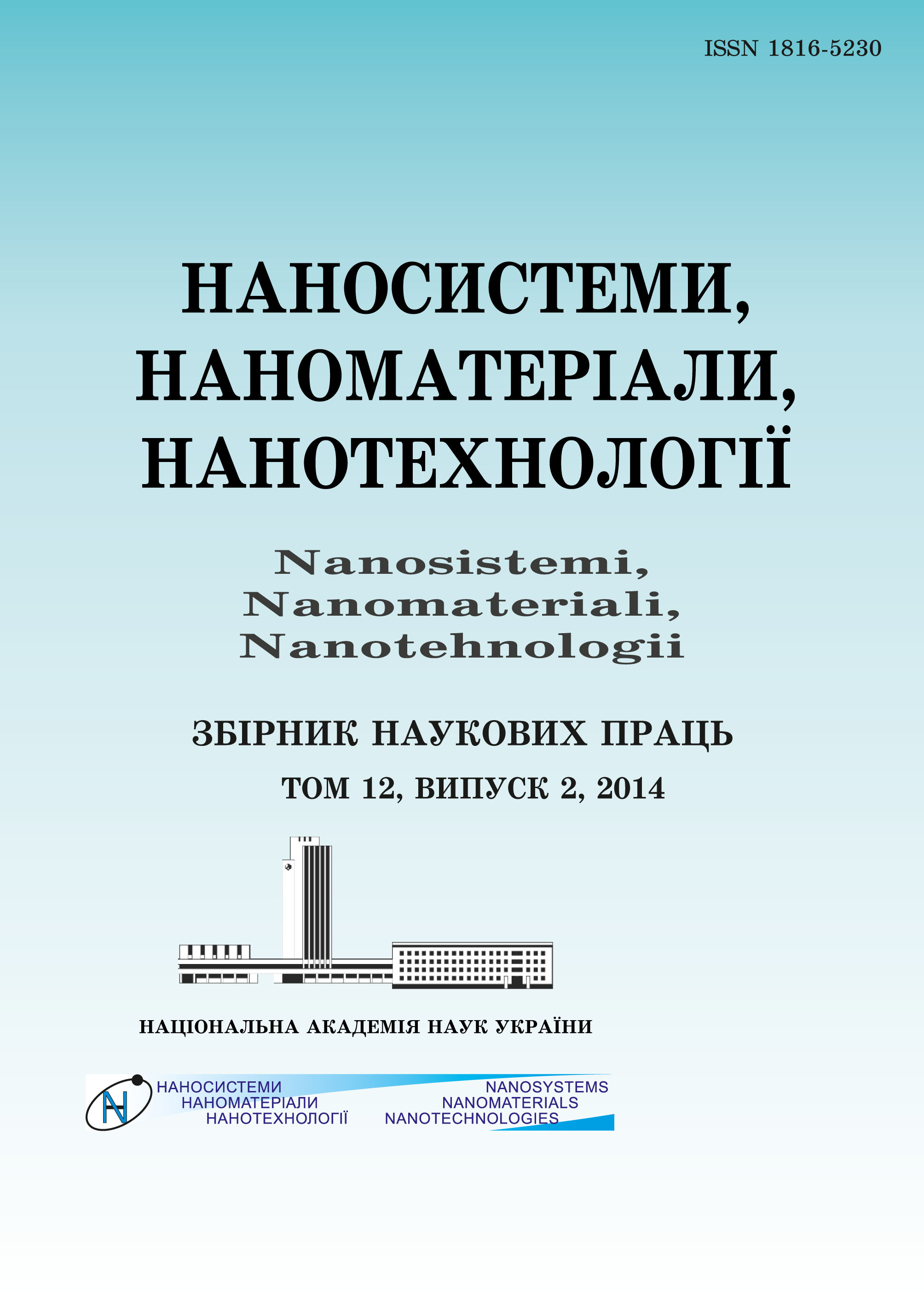|
|
|||||||||

|
Year 2025 Volume 23, Issue 2 |
|
|||||||
|
|||||||||
Issues/2025/vol. 23 /issue 2 |
|
P.E. TROFIMENKO1, M.V. NAIDA1, A.V. KHOMENKO1, M.M. LYAPA1, and D.O. SUSHYNSKYI2
1Sumy State University, 116 Kharkivska Str., UA-40007 Sumy, Ukraine
2Research Center of Missile Forces and Artillery, 165 Gerasym Kondratyev Str., UA-40021 Sumy, Ukraine
Dispersing Liquids by Rotating Sprayers
317–332 (2025)
PACS numbers: 47.20.Ib, 47.61.-k, 68.08.-p, 68.15.+e, 81.15.Rs, 82.70.Rr, 83.60.Wc
Dispersing liquids with rotating atomizers is one of the most effective techniques for obtaining dispersion systems with nanoparticles. The main purpose of dispersing devices is to transform a continuous flow of liquid into a dispersed system consisting of liquid droplets. There are two methods of converting liquid jets into thin films: hydrostatic (on an inclined plate) and centrifugal (on a film-forming blade). Liquid dispersion is an important technology that is used in various industries such as oil and gas industries, pharmaceutical, food, and other ones. Dispersing liquids with rotary atomizers has its advantages and disadvantages. On the one hand, this method is very effective, as it allows obtaining a homogeneous dispersion system with nanoparticles. On the other hand, the dispersion process can be quite complex, as its success depends on many factors, such as atomizer-rotation speed, droplet size, liquid properties, etc. In this article, we will look at the dispersion of liquids by rotating atomizers. This method makes it possible to obtain finely dispersed systems with a reduced particle size that opens up wide opportunities for improving the quality of the product. It is necessary to find new approaches to the design of atomizers with a large unit capacity. For their substantiation, fundamental theoretical studies should be conducted, and in order to correct the results, the theoretical analysis should be carefully checked and corrected by laboratory and industrial studies. The article shows the main principle schemes for rotating liquid atomizers (nozzle centrifugal atomizer, vane centrifugal atomizer, fan atomizer), and we will analyse, without going into technical details, their fundamental shortcomings, as well as possible directions of searching for ways to reduce energy consumption for dispersion and improve dispersed composition of droplets of sprayed liquid, and, in particular, obtaining a composition of droplets that is uniform in size. Important issues of fluid behaviour inside rotating cylindrical shells are considered. In addition, the features of the movement of the liquid, when it leaves the atomizer, are shown too.
KEY WORDS: liquid, droplet, dispersion, film former, centrifugal atomizer
DOI: https://doi.org/10.15407/nnn.23.02.0317
REFERENCES
- V. A. Borodin, Yu. F. Dytiatkyn, L. A. Klyachko, and V. I. Yagodkyn, Raspylivanie Zhydkostei [Dispersing of Liquids] (Moskva: Mashinostroyenie, 1967) (in Russian).
- D. H. Pazhy, V. S. Halustov, Osnovy Tekhnyky Raspylivaniya Zhydkostei [Basics of Techniques for Dispersing of Liquids] (Moskva: Khimiya: 1984) (in Russian).
- D. H. Pazhy, A. A. Koriahyn, and E. L. Lamm, Raspylivayushchie Ustroistva v Khimicheskoi Promyshlennosti [Dispersing Devices in Chemical Industry] (Moskva: Khimiya: 1975) (in Russian).
- W. R. Marshal and C. R. Adler, Chem. Eng. Prog., 47, No. 10: 52 (1951).
- H. P. Pyterskykh, TOKhT, 2: 745 (1981) (in Russian).
- P. Trofimenko and M. Naida, Int. Appl. Mech., 53, No. 1: 116 (2017); https://doi.org/10.1007/s1077
- B. T. Emtsev, Tekhnicheskaya Hidromekhanika [Technical Hydrodynamics] (Moskva: Mashinostroyenie: 1978) (in Russian).
- A. G. Kasatkin, Osnovnyye Protsessy i Apparaty Khimicheskoy Tekhnologii [Basic Processes and Apparatuses of Chemical Engineering] (Moskva: Khimiya: 1975) (in Russian).
- B. G. Kholin, Tsentrobezhnyye i Vibratsionnyye Granulyatory Plavov i Raspyliteli Zhidkosti [Centrifugal and Vibration Granulators of Melts and Liquid Sprayers] (Moskva: Mashinostroyenie: 1977) (in Russian).
- P. E. Trofimenko, M. V. Naida, and A. V. Khomenko, Nanosistemi, Nanomateriali, Nanotehnologii, 18, Iss. 3: 565 (2020) (in Ukrainian); https://doi.org/10.15407/nnn.18.03.565
- P. E. Trofimenko, M. V. Naida, A. V. Khomenko, and Yu. I. Pushkarov, Nanosistemi, Nanomateriali, Nanotehnologii, 20, Iss. 3: 657 (2022); https://doi.org/10.15407/nnn.20.03.657
- A. D. Pogrebnjak, M. A. Lisovenko, A. Turlybekuly, and V. V. Buranich, Phys.-Usp., 64, No. 3: 253 (2020); https://doi.org/10.3367/UFNe.2020.08.038823
- O. V. Khomenko, A. A. Biesiedina, K. P. Khomenko, and R. R. Chernushchenko, Prog. Phys. Met., 23, No. 2: 239 (2022); https://doi.org/10.15407/ufm.23.02.239
- О. А. Goncharov, D. A. Belous, A. N. Yunda, A. V. Khomenko, E. V. Mironenko, L. V. Vasilyeva, and C. A. Goncharova, Nanosistemi, Nanomateriali, Nanotehnologii, 20, Iss. 2: 385 (2022); https://doi.org/10.15407/nnn.20.02.385
- O. Mazur, K. Tozaki, and L. Stefanovich, Solid State Commun., 361: 115072 (2023); https://doi.org/10.1016/j.ssc.2023.115072
- A. Khomenko, D. Boyko, and K. Khomenko, Mol. Cryst. Liq. Cryst., 719, Iss. 1: (2021); https://doi.org/10.1080/15421406.2020.1860531
- A. V. Khomenko, I. A. Lyashenko, and L. S. Metlov, Metallofiz. Noveishie Tekhnol., 30: 859 (2008).
- A. Khomenko, D. Troshchenko, and L. Metlov, Phys. Rev. E, 100: 022110 (2019); https://doi.org/10.1103/PhysRevE.100.022110
 This article is licensed under the Creative Commons Attribution-NoDerivatives 4.0 International License ©2003 NANOSISTEMI, NANOMATERIALI, NANOTEHNOLOGII G. V. Kurdyumov Institute for Metal Physics of the National Academy of Sciences of Ukraine. E-mail: tatar@imp.kiev.ua Phones and address of the editorial office About the collection User agreement |